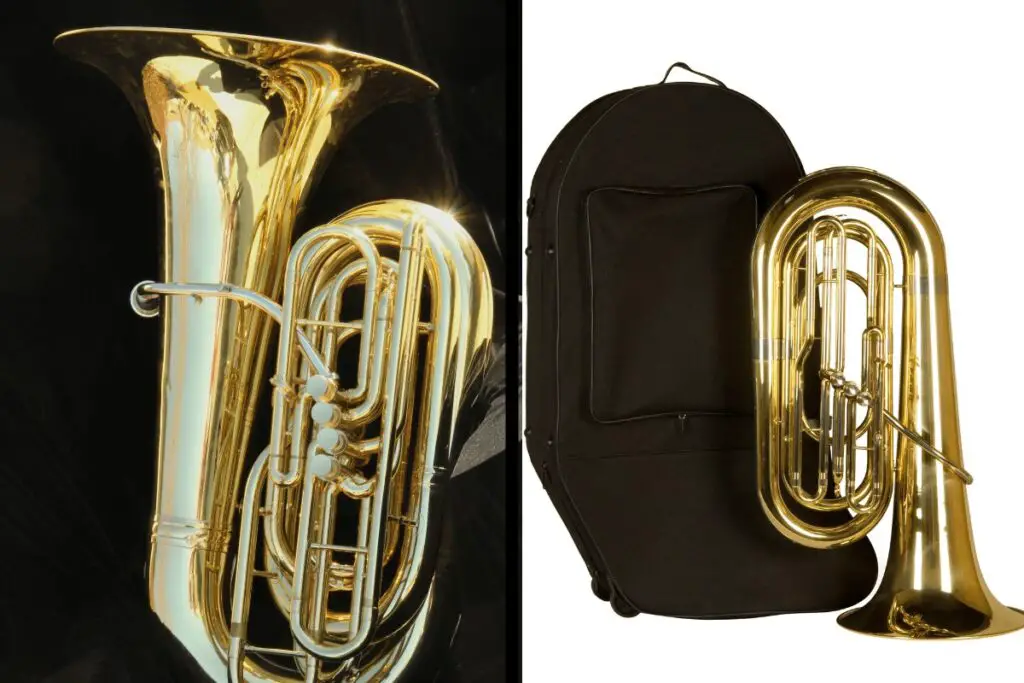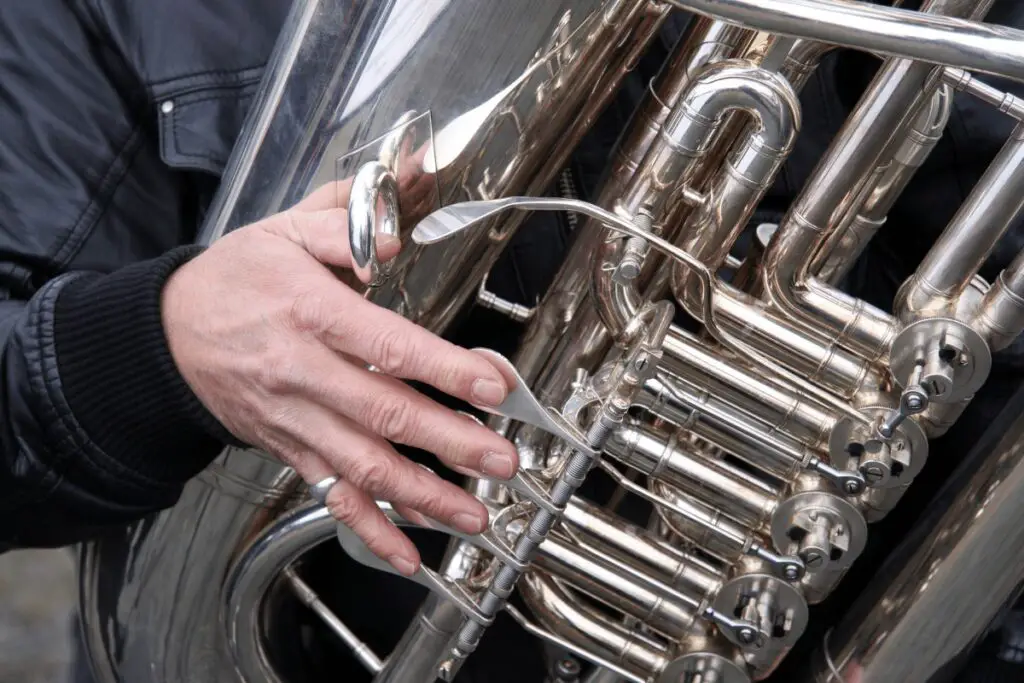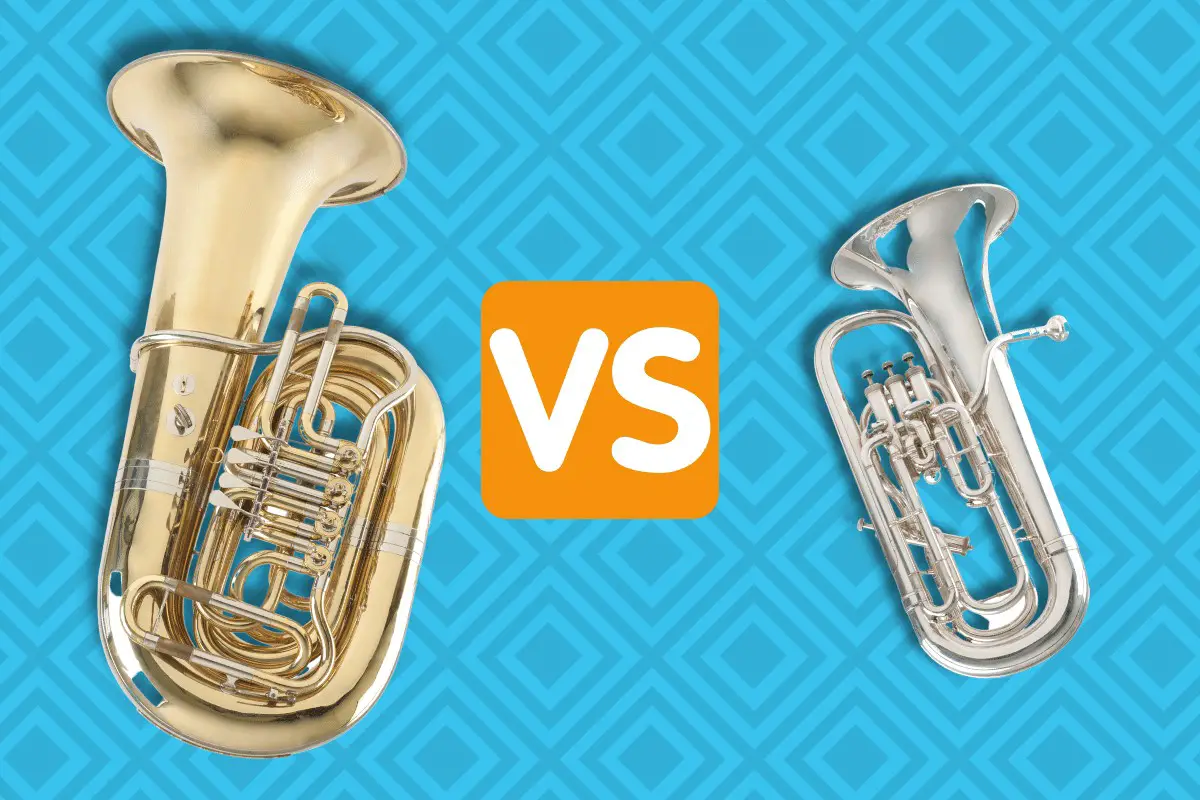I’ve noticed something over my years playing the tuba and teaching music:
Most people don’t recognize the difference between tuba and euphonium.
I get where this confusion is coming from, though.
They are closely related, after all.
They are so closely related, in fact, that I decided to write this Tuba Vs. Euphonium guide to help people realize the main differences and similarities between these two awesome brass instruments.
The tuba is the lowest brass instrument and uses valves to change its pitch. The euphonium is designed almost exactly like the tuba and generally plays an octave above. A tuba uses 18′ feet for tubing for its fundamental compared to the euphonium’s 9′ feet.
Look ahead for more details explained (with video too!).
Note: All the information for the euphonium described here works for the baritone as well, except where noted.
Hey! If you like tuba stuff, check out my Instagram!
Table of Contents
Tuba Vs. Euphonium Direct Comparison
| Tuba | Euphonium | |
|---|---|---|
| Length | 18′ feet | 9′ feet |
| Fundamental Octave | Bb1* | Bb2 |
| Family of Instruments | Brass | Brass |
| How They Change Pitch | Valves (Piston or Rotary) | Valves (All Piston Valves) |
| Bore Design | Conical tubing | Conical tubing |
| Purpose In Ensembles | Bass | Tenor voice, adds harmony, sometimes melody |
| Commonly Found In | Concert Band, Marching Bands, Brass Band, Orchestra, German Band, Brass Quintets | Concert Band, Marching Bands, Brass Band, German Band |
*This is assuming the tuba in question is a BBb tuba (the most common).
CC, Eb, and F tubas are also common.
Related reading: Check out our list of the best F tubas for some solo horns perfect for fitting in between the tuba and euphonium.
How Are Tuba And Euphonium The Same?

First, we need to look at how these two musical instruments are the same.
Historically, the tuba came first, and the euphonium was invented later based on the design of the tuba.
For this reason, they are very similar in design, though they differ somewhat in function.
Fun fact: Some people call the euphonium a tenor tuba.
Appearance
Of course, both of these being based on the same instrument design (tuba first), they look very similar.
In fact, most people can’t tell them apart from a picture; they need to see them side by side to tell.
Usually, the tuba’s valves are on the front (but not always), and the euphonium’s valves are in the middle and face up.
The picture at the beginning of this section shows this well.
Instrument Family
Both tuba and euphonium are members of the brass family.
Despite the name, a brass instrument doesn’t have to be made of brass, though it typically is.
The key to all brass instruments comes in how the vibration is produced.
Any brass family instrument must buzz its lips to produce sound.
Usually, this is done into a circular mouthpiece that fits into the lead pipe of the instrument.
Both tuba and euphonium use a mouthpiece to buzz their lips to produce sound.
The shape of the metal, the length of the piping, and the quality of the construction all affect the overall sound, but the source of the vibration comes from the lips.
Literature
As both the tuba and the euphonium are newer instruments in the music world (only developed in the 1800s and rising in popularity in the middle and late 1900s), they share a lot of the same literature.
Solos written for tuba were also often written for euphonium and vice versa.
It was often expected that a player would be able to play both tuba and euphonium equally well, though this has faded in the musical world lately.
Euphoniums will also borrow from trombone literature as they play in the same range of notes, and tubas will borrow from other low instruments such as the double bass or bassoon.
Still, in terms of exercises and learning, tuba players and euphonium players pull from a lot of the same stuff.
Speaking of solos, check out this comprehensive list of famous tuba solos to add to your repertoire.
Fingerings (Mostly)
Tuba and Euphonium fingerings line up for most brass players (assuming you’re playing a BBb tuba which is true in most cases except at the collegiate level).
Both are C instruments with a Bb as their fundamental.
This means they play a Bb with no valves pressed down.
From there, all the other combinations are the same with the first 4 valves.
Tubas will occasionally add a fifth valve or more (usually only on professional horns, which are in CC, Eb, or F typically).
Professional euphoniums also add a fifth valve on occasion, though their fifth valve is often played with their other hand (as opposed to the tuba player’s thumb).
Euphoniums exclusively use piston valves, but tubas may use rotary valves or pistons equally, depending on the design.
Both are non-transposing instruments, though many euphonium players who switch from trumpet will prefer reading in treble clef (which then makes them transpose).
Lesson Teachers
Though euphonium is still rising in popularity, it’s still not as common or widespread as the tuba.
As such, there aren’t nearly as many teachers out there for it.
Often, a euphonium player who also teaches lessons will be expected to teach tuba players in their studio (lesson load).
The same is true the other way as well.
Without either a tuba or euphonium teacher out there, it’s also not uncommon to find a trombone player giving lessons to both of these players, though this is less than ideal.
Tuba teachers who teach euphonium are still much more common because there is simply more demand for tuba players out there.
Conical Bore
Both of these brass wind instruments are a conical bore.
This means the tubing gets wider through the length of the horn until it flares out at the bell.
Think about the core of the word “cone.”
A cone is smaller on one end and wider on the other, but it moves outward in an even growth pattern.
A tuba and euphonium tube is similar to this.
In general, a conical instrument offers a darker, rounder sound.
Conical brass instruments include:
- Cornet
- Flugelhorn
- French Horn
- Euphonium
- Tuba
Note: It’s here we see the major difference between euphonium and baritone, which are identical except for their bore shape.
Euphoniums are conical, and baritones are cylindrical bore, meaning the tubing stays the same size until it flares out at the bell.
Tuba And Euphonium Differences

As similar as they are, these two instruments are not the same.
In this section, we’ll talk about the key differences.
Range
The tuba and the euphonium are an octave apart from each other, with the tuba being lower.
Most tubas used in the world are BBb tubas (which are a full octave lower), with the CC tuba a close second (a minor 7th lower).
In general, this starting pitch, or fundamental) extends to their functional range as well.
A euphonium’s range is much closer to the trombone than the tuba.
Eb and F tubas are rarer, and they fit in between the normal tuba and euphonium in terms of range.
All of these brass instruments have a wide range of pitches available to them.
Purpose/Use In Ensembles
While similar in design, they are used for completely different reasons in musical ensembles.
Tubas are the basses.
They provide support for the whole band or orchestra when they play.
A great tuba player will make any ensemble sound instantly head and shoulders better.
(Yes, this is biased of me, but I’ve confirmed this with many of my school band director friends.)
The euphonium fills the tenor role similar to the trombone or tenor saxophone.
It provides harmony and will sometimes get some interesting counter-melodies or even the lead melody in pieces.
The tuba is used more often in a wide variety of groups.
The poor euphonium isn’t used a lot.
Brass bands, concert bands, and German bands are the only places you’ll find them consistently.
But the tuba will show up to some degree in almost every ensemble.
Size And Weight
As we’ve touched on before, the size of the two instruments is key.
The tuba is, for its Bb note, around 18′ feet long, and it’s clearly the larger instrument.
The euphonium, for its fundamental, is around 9′ feet long.
This size and weight transfer along with this same general trend across all valve combinations and weights, with the euphonium being 50% of the size of the tuba.
A lot of euphonium players will stand when they play solos and sit when they play in groups.
For tubas, it’s all sitting in almost all cases.
Tuba And Euphonium Examples
For a good direct example of the tuba and euphonium, let’s take a look at the same solo played by a tuba and euph pro.
In the following section, I’ll include links to similar models to check out for price and specific features.
Are Euphonium And Baritone The Same Instrument?
The euphonium and baritone are essentially the same instruments except for their bore. Euphoniums are a conical bore and have a mellow, dark sound. Baritones are cylindrical bores with a brighter sound. Most of the time, you see a “baritone,” it’s actually a euphonium.
Don’t get me wrong; both have a rich tone.
It’s just a different type of sound.
Euphoniums are used in most groups where you’ll find this size of the instrument, whereas baritones are used almost exclusively in British brass bands.
In this group, you’ll even find euphoniums and baritones in separate sections with separate parts!
Is A Euphonium A Small Tuba?
A euphonium is essentially a small tuba that plays an octave higher than the standard bass tuba. This is true mainly in the design of the euphonium, though in use, this “mini-tuba” rarely plays the part that the tuba covers in ensembles.
Is Tuba Better Than Euphonium?
Picking whether or not the tuba is better than the euphonium is purely a personal opinion. In terms of use and places to play, though, you’ll get more play time if you play the tuba as it’s used in more groups and plays a unique role.
Can Tuba Players Play Euphonium?
Many tuba players also play euphonium and vice versa. Tuba professors are often expected to be professional euphonium players, too (as the opposite is as well). In general, though, if you want to be really good at one, you have to specialize.

